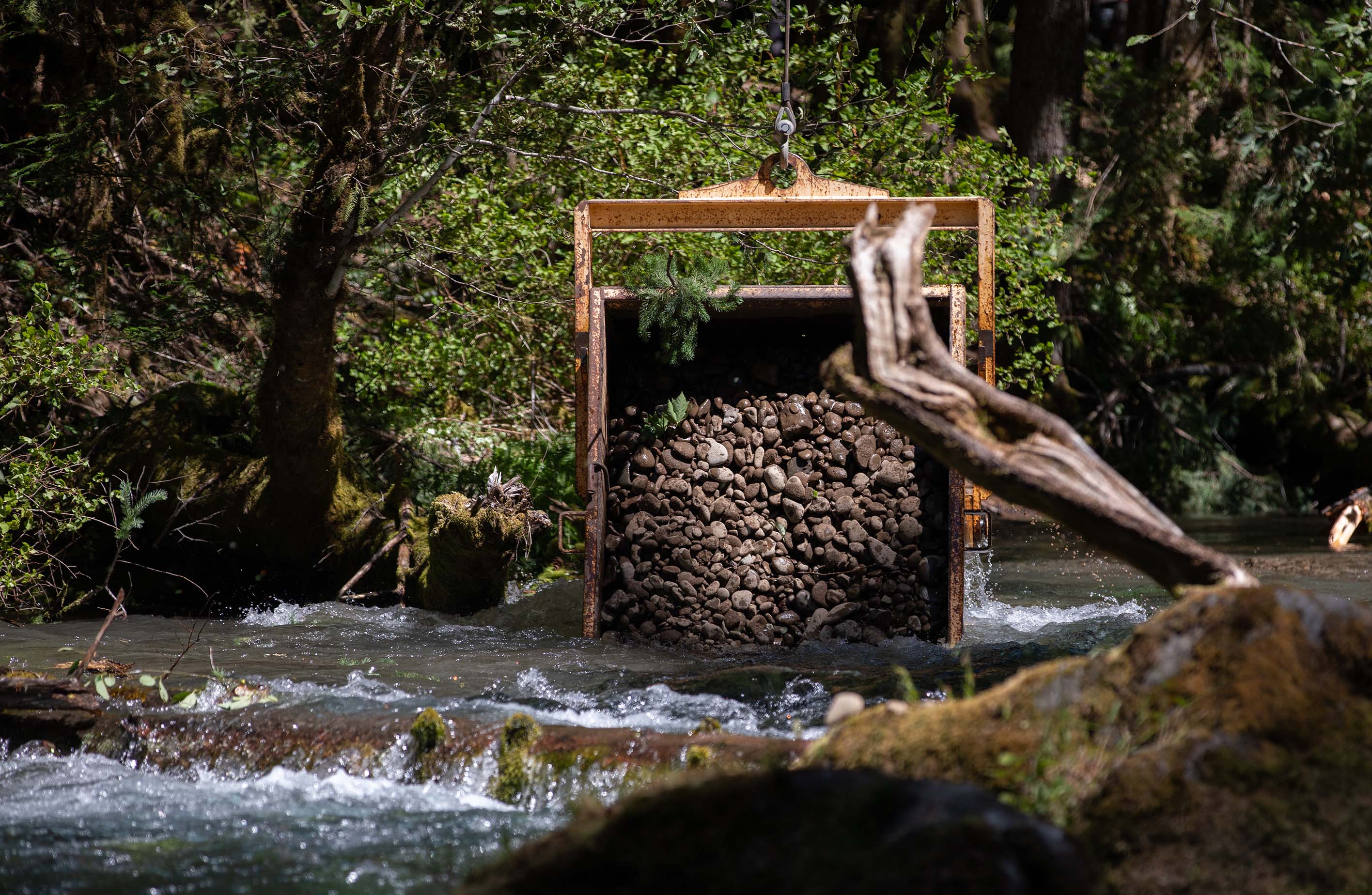Related News
Related News
-
Energy shortfall of 9 gigawatts projected for the Northwest
By 2030, a dry year combined with soaring energy demand during extended cold snaps could lead to rolling blackouts, a new study warns.
Find Out More -
Sustainability Snapshot - Celebrating Energy Efficiency Projects in the Community
Sustainability Snapshops highlight impactful projects completed by EWEB's Customer Solutions department, as a way to celebrate the meaningful work happening behind the scenes.
Find Out More -
McKenzie Valley electric service territory realignment study reaches key milestone
EWEB Commissioners approved a resolution authorizing the General Manager to negotiate and execute agreements with Lane Electric Cooperative regarding a potential realignment of electric service territory in the McKenzie Valley at the Board’s December meeting.
Find Out More -
EWEB secures $2.5 billion of reliable, affordable, carbon-free energy for customers
The new contract with EWEB’s largest energy supplier, the Bonneville Power Administration, forms the foundation of a diverse energy portfolio.
Find Out More -
Women in STEM: Meet the Hydro Project Engineer Building Habitat for Salmon
EWEB Engineer Associate Val Chang found her way to the McKenzie River from Los Angeles, inspired by heritage trips to the waters of Taiwan and key mentors along the way.
Find Out More -
Public Power Week Poster Contest Winners 2025
The results are in! View the winning posters from EWEB's 2025 Public Power Week Poster Contest.
Find Out More -
EWEB Hometown Heroes compete internationally
Out of 290 teams from 14 different countries, EWEB's Lineman Rodeo team places in the top third of competitors.
Find Out More -
EWEB's Halloween Truck-or-Treat is a huge success
Community members are accustomed to spotting EWEB trucks around Eugene streets and neighborhoods. But last week, those familiar vehicles looked a little different. At EWEB's second annual Truck-or-Treat Customer and Crew Appreciation Event, our fleet transformed into a festive Halloween spectacle.
Find Out More -
Let's Talk Turkey. Is your family ready for winter?
We're heading into the holidays, but that also means snow, ice, and not-so-nice weather might be in the forecast. Here are some tips to prepare in advance.
Find Out More -
Vote for your favorite Public Power Week Posters
The top five submittals will receive awards. Help us pick the winners.
Find Out More -
EWEB Hosts Annual Spill Drill to Protect McKenzie River
EWEB led emergency responders in its annual “spill drill” on the McKenzie River on Wednesday, Oct. 15, at the Trail Bridge Campground.
Find Out More -
Electric Projects underway in North & South Eugene
Underground lines and disaster-resilient power poles are part of EWEB’s infrastructure upgrade near Eugene’s largest natural resource area.
Find Out More -
EWEB general manager to retire in 2026
EWEB launches nationwide search for next leader to continue the progress of the last decade and ensure a smooth transition.
Find Out More -
The Bonneville Power Administration Rate Change and Your EWEB Bill
BPA’s finalized rate increase is smaller than projected, and EWEB’s pass-through adjustment effective October 1, 2025 will now be 2.7% for residential customers—down from the anticipated 4%.
Find Out More -
Quartz Creek: Setting the Stage for Floodplain Restoration
The project resets the floodplain along 1.8 miles of a formerly channelized creek to improve water quality, fish habitat and natural disaster resiliency.
Find Out More - Show More
EWEB completes helicopter installation of salmon habitat features
August 19, 2025 • Adam Spencer, EWEB Communications

EWEB successfully completed major habitat improvement work on the upper McKenzie River as part of the 2016 settlement agreement for relicensing the Carmen-Smith Hydroelectric Project.
The Lower Carmen Bypass Reach Habitat Enhancement Project added 2000 tons of gravel and twenty bundles of brushy treetops by helicopter, and ten large trees pulled into the river by a cable yarder.
Threatened Chinook salmon and bull trout need gravels to build their spawning nests, called redds. Branchy trees in the water provide cover where young fish can hide from predators. Gravels and trees also add complexity to the river, creating pools for fish to rest in and rapids to oxygenate eggs.
This part of the Upper McKenzie has very little gravel, as the reach is below Tamolitch Falls, where the McKenzie emerges from below a layer of volcanic rock.
“It's a very young stream just upstream of here. We have lava flows as recently as 3000 years. And so there's just not a lot of naturally occurring gravel. So part of what we're doing is creating that habitat,” said EWEB Fisheries Biologist Andy Talabere.
As the river reforms at the famously cold Blue Pool, this section of the McKenzie is the highest and coldest habitat salmon will have as they face a warming future.
“This reach is particularly important as we head into more and more climate change. As we’re looking at the potential for fish to continue to move further upstream, to be in colder and colder habitat, it's definitely a resiliency piece to make this more of a climate refuge for fish than it already is,” Talabere said.
The complex project required multiple specialties. EWEB hired Inter-Fluve to analyze the riverscape and design the habitat enhancements. Eugene-based Wildish was the Construction Manager and General Contractor overseeing ecological construction firm Biohabitats. Since there are no roads along this section of Wild and Scenic River, it was necessary to bring in Columbia Helicopters to place the gravels and treetops. Blue Ridge Timber Cutting pulled the large trees into the reach.
“There really is quite an artistic touch to this. And I think our biologists on our team, as well as our design engineers, they have a real heavy hand in shaping the artistry that is habitat restoration,” said EWEB Engineering Associate Val Chang, who oversaw the project.
“There's a biologic fit to it that I think our team handles really well. You really come out here and see how the river is behaving and you make adjustments in the river accordingly.”
The pilot showed off his artistry, too, intricately placing a 6,000-pound gravel bucket into specific riffles of the river, then lowering a brace arm on the bucket to release and tip the gravel, all while avoiding branches on the way down and back up.
“I'm proud to be a part of this restoration project. It's been, a great learning experience for me and, so far, very smooth operation – very safe,” Wildish Superintendent Aaron Hamrick said.
The project required weekday closures to the Blue Pool Trailhead to protect recreators from potential hazards due to overhead and heavy machinery work. The trail is one of the most popular hiking destinations in the area and parallels the river where the work occurred. Now that the heavy machinery work is completed, the trail will be open as usual.
“We've worked in partnership with the Forest Service, to set up a closure order for a portion of the area where we see a lot of recreation,” Chang said. “So I really appreciate the collaboration with all the agencies that have worked together on this – this has been really quite a heavy lift.”

